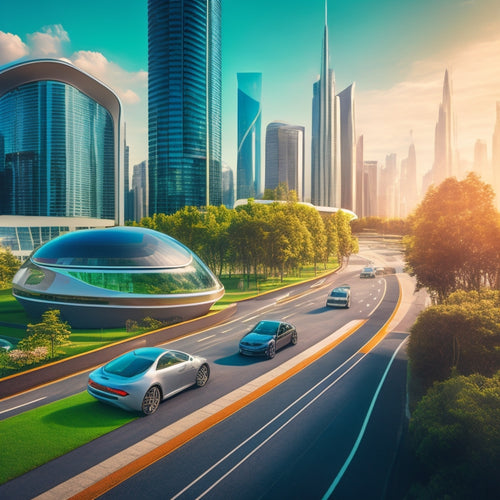
Designing Efficient Residential Renewable Energy Systems
Share
As you design an efficient residential renewable energy system, you'll need to take into account multiple factors to guarantee a cost-effective shift to sustainable energy. Start by optimizing solar panel installation, taking into account energy output, orientation, and compliance with local building codes. Next, assess your roof's layout and orientation to maximize energy production while ensuring structural integrity. Don't forget to evaluate shading and obstruction losses, and conduct an energy audit to identify areas for improvement. By addressing these key aspects, you'll be well on your way to creating a seamless and efficient renewable energy system - and there's even more to discover as you move forward.
Key Takeaways
• Ensure optimal solar panel installation by considering energy output, orientation, tilt, and spacing to prevent reduced energy output and safety hazards.
• Optimize roof layout and orientation to maximize energy production, enhance visual appeal, and maintain structural integrity.
• Assess shading and obstruction losses by identifying and quantifying potential losses from tree canopies, building facades, and roof obstructions.
• Conduct an energy audit to identify areas of energy inefficiency, upgrade to energy-efficient alternatives, and calculate total energy load required.
• Determine ideal inverter size, optimize string configuration, and choose high-efficiency inverters to ensure efficient energy conversion and monitoring.
Solar Panel Installation Design Principles
When designing a solar panel installation, you must take into account the system's energy output, which is primarily determined by the panel's orientation, tilt, and spacing. These factors have a notable impact on the amount of energy your system can produce. It's crucial to make sure that your installation complies with local building codes and electrical infrastructure requirements. Failure to do so may result in reduced energy output, safety hazards, or even system failure.
As you design your solar panel installation, keep in mind that building codes dictate specific requirements for electrical infrastructure, including wiring, grounding, and connection standards. Ensure that your system's electrical infrastructure is compatible with your local grid and meets the necessary safety standards.
Additionally, consider the electrical infrastructure's capacity to handle the system's energy output, avoiding potential bottlenecks that could reduce energy production. By prioritizing these design principles, you'll be well on your way to creating an efficient and safe solar panel installation that meets your energy needs while adhering to local regulations.
Optimizing Roof Layout and Orientation
To maximize energy production, you'll need to carefully consider the roof's layout and orientation, as even minor variations in panel placement can greatly impact your system's overall energy output. A well-designed roof layout won't only enhance energy production but also guarantee a visually appealing installation that complements your home's architecture.
When optimizing your roof layout, take into account the structural integrity of your roof to make sure it can support the weight of the solar panels. It's crucial to assess the roof's condition, including any weaknesses or vulnerabilities, to avoid compromising its structural integrity.
Additionally, roof aesthetics play a significant role in the design process. You'll want to balance energy production with visual appeal, ensuring the solar panels blend seamlessly with your home's design. By carefully planning the layout and orientation of your solar panels, you can create a harmonious and efficient renewable energy system that meets your energy needs while maintaining your home's curb appeal.
Assessing Shading and Obstruction Losses
Shading and obstructions can greatly diminish your residential renewable energy system's performance, so it's important you identify and quantify potential losses to guarantee accurate energy production estimates.
When evaluating shading and obstruction losses, you need to take into account the following factors:
-
Tree Canopy: Trees surrounding your residential building can cast shadows on your renewable energy system, reducing its efficiency. You'll need to factor in the tree canopy's impact on your system's performance.
-
Building Facades: Adjacent buildings or your own building's facade can cast shadows or obstruct sunlight from reaching your renewable energy system. You must measure these losses to make accurate energy production estimates.
-
Roof Obstructions: Vent pipes, skylights, and other roof features can cast shadows or obstruct sunlight, reducing your system's performance. You'll need to identify and accommodate these obstructions.
- Nearby Structures: Nearby structures, such as garages or sheds, can also cast shadows or obstruct sunlight. You must take into account these potential obstructions when evaluating shading and obstruction losses.
Energy Efficiency and Load Calculation
Now that you've assessed shading and obstruction losses, you'll need to calculate the energy efficiency and load requirements of your residential renewable energy system to verify it meets your energy needs. This involves conducting an energy audit to identify areas of energy inefficiency and opportunities for improvement.
Start by evaluating the energy efficiency of your appliances, lighting, and HVAC systems. Look for opportunities to upgrade to energy-efficient alternatives, such as LED lighting and Energy Star-rated appliances.
Next, calculate the total energy load required to power your home. This includes the energy required for heating, cooling, lighting, and powering appliances. You can use online tools or consult with a professional to determine your energy load. Be sure to account for any energy-intensive appliances, such as electric water heaters or pool pumps.
Inverter Sizing and String Configuration
You'll need to determine the ideal inverter size and string configuration to guarantee your renewable energy system efficiently converts DC power from your solar panels to usable AC power for your home.
A well-designed grid-tie system relies on the best inverter sizing to ensure efficient energy conversion. To achieve this, consider the following key factors:
-
System capacity: Make sure the inverter's maximum power point tracking (MPPT) capacity matches your solar panel array's maximum power output.
-
String configuration: Optimize string lengths and configurations to minimize losses and maximize energy harvesting.
-
Inverter efficiency: Choose an inverter with high efficiency ratings (>95%) to minimize energy losses during conversion.
- System monitoring: Implement a monitoring system to track inverter performance, ensuring timely detection of any issues or inefficiencies.
Monitoring and Performance Analysis Tools
To optimize system performance and troubleshoot issues, it's vital that you utilize monitoring and performance analysis tools that provide real-time data on energy production, consumption, and system health. With these tools, you can identify areas for improvement, detect potential issues, and guarantee your system operates at its best.
| Tool Feature | Benefits |
| Real-time Data Monitoring | Enables prompt identification of performance issues |
| Data Visualization | Provides clear insights into system performance trends |
| Real-time Alerts | Notifies you of potential issues before they become major problems |
| Customizable Dashboards | Allows you to tailor your monitoring experience to your specific needs |
Simulating Energy Production and Savings
By simulating energy production and savings, you can accurately predict the performance of your residential renewable energy system and make informed decisions about its design and optimization. Energy modeling software allows you to analyze various system configurations, taking into account factors like local weather patterns, roof orientation, and energy usage patterns. This enables you to identify the most efficient system design and optimize its performance.
Here are some key benefits of simulating energy production and savings:
-
Accurate financial projections: By estimating energy production and savings, you can create reliable financial projections, including payback periods and return on investment.
-
Optimized system design: Simulation helps you identify the most efficient system configuration, reducing energy waste and maximizing energy production.
-
Energy efficiency optimization: You can analyze and optimize energy usage patterns, reducing energy consumption and costs.
- Data-driven decision-making: Simulation provides actionable insights, enabling you to make informed decisions about your residential renewable energy system.
Frequently Asked Questions
Can I Install Renewable Energy Systems in Apartments or Rented Homes?
You can install renewable energy systems in apartments or rented homes, but you'll need landlord approval, ensuring renter benefits like reduced energy bills and increased property value, while also considering local regulations and incentive programs.
How Long Does the Average Residential Renewable Energy System Last?
'Rome wasn't built in a day,' but you're wise to prioritize longevity. On average, your residential renewable energy system can last 25-30 years, ensuring energy durability and a long system lifespan, giving you peace of mind and a strong return on investment.
Are Renewable Energy Systems Safe for Wildlife and Pets?
As you consider renewable energy systems, you'll want to know they're safe for wildlife and pets. Fortunately, most systems are designed to minimize habitat disruption and prioritize species protection, ensuring a harmonious coexistence with nature.
Can I Sell Excess Energy Back to the Electrical Grid?
"As you weave a safety net of sustainability, you'll find that, yes, you can sell excess energy back to the grid, earning a Grid Payment, and engaging in Energy Trading, a harmonious dance of give-and-take with the electrical grid."
Do Renewable Energy Systems Require Frequent Maintenance?
You'll be relieved to know that renewable energy systems don't require super frequent maintenance; regular servicing and preventive checks will keep them running smoothly, ensuring peak performance and minimizing downtime.
Related Posts
-

Master Advanced Solar Panel Design Online for Free
You can master advanced solar panel design online for free by leveraging specialized courses and training platforms, ...
-

Charging Station Incentives: Why So Many Are Free
You're likely to stumble upon free or low-cost charging stations due to a convergence of incentives. Government rebat...
-

Planning for an Electric Vehicle-Friendly Urban Future
As you plan for an electric vehicle-friendly urban future, you'll need to integrate high-power charging stations, sma...


